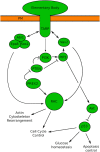Conjunctival fibrosis and the innate barriers to Chlamydia trachomatis intracellular infection: a genome wide association study
- PMID: 26616738
- PMCID: PMC4663496
- DOI: 10.1038/srep17447
Conjunctival fibrosis and the innate barriers to Chlamydia trachomatis intracellular infection: a genome wide association study
Abstract
Chlamydia trachomatis causes both trachoma and sexually transmitted infections. These diseases have similar pathology and potentially similar genetic predisposing factors. We aimed to identify polymorphisms and pathways associated with pathological sequelae of ocular Chlamydia trachomatis infections in The Gambia. We report a discovery phase genome-wide association study (GWAS) of scarring trachoma (1090 cases, 1531 controls) that identified 27 SNPs with strong, but not genome-wide significant, association with disease (5 × 10(-6) > P > 5 × 10(-8)). The most strongly associated SNP (rs111513399, P = 5.38 × 10(-7)) fell within a gene (PREX2) with homology to factors known to facilitate chlamydial entry to the host cell. Pathway analysis of GWAS data was significantly enriched for mitotic cell cycle processes (P = 0.001), the immune response (P = 0.00001) and for multiple cell surface receptor signalling pathways. New analyses of published transcriptome data sets from Gambia, Tanzania and Ethiopia also revealed that the same cell cycle and immune response pathways were enriched at the transcriptional level in various disease states. Although unconfirmed, the data suggest that genetic associations with chlamydial scarring disease may be focussed on processes relating to the immune response, the host cell cycle and cell surface receptor signalling.
Figures





References
-
- Rowley J., Toskin I. & Ndowa F. Global Incidence and Prevalence of Selected Curable Sexually Transmitted Infections, 2008. World Health Organisation. (2008).
-
- Guzey M. et al. A survey of trachoma: the histopathology and the mechanism of progressive cicatrization of eyelid tissues. Ophthalmologica. 214, 277–84 (2000). - PubMed
-
- al-Rajhi A. A., Hidayat A., Nasr A. & al-Faran M. The histopathology and the mechanism of entropion in patients with trachoma. Ophthalmology 100, 1293–6 (1993). - PubMed
Publication types
MeSH terms
Grants and funding
- MR/M01360X/1/MRC_/Medical Research Council/United Kingdom
- 075491/Z/04/WT_/Wellcome Trust/United Kingdom
- 105609/Z/14/Z/WT_/Wellcome Trust/United Kingdom
- G0600718/MRC_/Medical Research Council/United Kingdom
- 100714/WT_/Wellcome Trust/United Kingdom
- GR079246MA/WT_/Wellcome Trust/United Kingdom
- 077012/Z/05/Z/WT_/Wellcome Trust/United Kingdom
- 090532/Z/09/Z/WT_/Wellcome Trust/United Kingdom
- WT093368MA/WT_/Wellcome Trust/United Kingdom
- WT098051/WT_/Wellcome Trust/United Kingdom
- MR/K000551/1/MRC_/Medical Research Council/United Kingdom
- MR/M006212/1/MRC_/Medical Research Council/United Kingdom
LinkOut - more resources
Full Text Sources
Other Literature Sources
Molecular Biology Databases

